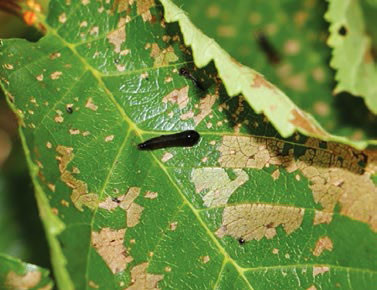Every year around this time, just as the weather starts to warm and the garden wakes up properly, we see the same old characters returning for their seasonal buffet — pear and cherry slug. If your pear, cherry or quince leaves are starting to look a little lacey or “skeletonised”, you’re seeing the first wave right on schedule. They’ve pupated quietly in the soil all winter, biding their time, and now they’re back up the trunk with a good appetite.
I always remind people that while the trees will cope with one attack, repeated seasons of heavy feeding really do knock them around. The leaves are the tree’s engine room, and when they’re chewed back to skeletons year after year, fruit quality and overall vigour start to slide. This is the time to catch them early, act gently and stay ahead of the next round that always comes later in summer.
At Harmony we stick firmly to organic principles because we want to protect the living systems in your garden, not strip them back. The temptation is always there to grab something harsh and wipe everything out, but chemicals don’t pick and choose. They harm the very pollinators and beneficial insects that spend the rest of the year working quietly in your favour. For us, it’s a simple choice: protect the bees, protect the soil life, and the garden pays you back tenfold.
A few treatments have been passed around for generations, and some still have their place if used carefully. Diatomaceous earth is a good example. It works, but you have to respect it. Only use it on a still day because the last thing you want is the dust blowing back into your face. It’s designed to dry out soft-bodied insects, and your eyes and lungs definitely don’t need that. Tap it lightly across the foliage and it’ll take the shine off the slugs pretty quickly.
Garden lime is another one of those old remedies, and while it can work, it really is hit and miss. Too much and it burns foliage, too little and it does almost nothing, and if the leaf surface isn’t just right it simply won’t cling. I only suggest lime for those who’ve used it for years and understand how to handle it, because it’s not the friendliest option for beginners.
Our preferred treatment — and the one that aligns completely with our Harmony values — is Dipel. It’s organic, it targets the larval stage beautifully, and it doesn’t harm bees, birds, pets or beneficial insects. It’s gentle, it works, and it lets the rest of the garden life carry on doing what it does best. A light spray over the affected leaves is usually all it takes.
Even with a good treatment, it’s worth remembering that pear and cherry slug is a repeat visitor. They pupate in the soil and you’ll often see a second wave later in summer. Knowing this helps you stay ready. Keep an eye on your pear, cherry and quince trees from now until autumn and you’ll interrupt their cycle before they can cause real harm.
Everything we do at Harmony comes back to the same belief — a garden is a living, breathing community. If we protect that community, it thrives. Managing pests like pear and cherry slug organically is just part of that bigger picture. It’s about balance, observation and acting gently when the time is right.
If you’re not sure what you’re dealing with, bring in a leaf or show us a photo. We arealways happy to help you sort out what’s chewing on what, and how to bring things back into balance without harming the good guys.

